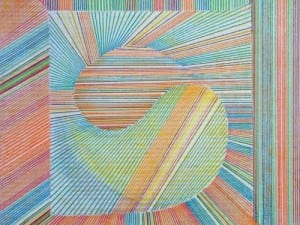Musical instrument designers are pushing their creations in new and unexpected directions. In the process, the instruments themselves are becoming a lot more than just tools for making music.
Adam Place had always been musical. He’d grown up singing and playing the piano, and at university he dove headlong into sound production. His world was one of DAWs, or Digital Audio Workstations, the cumbersome industry name for the music production software behind most modern recordings.
And it was while playing around in one of these that Place had an intriguing thought. He was looking at the in-built software instruments – the synths and samplers – and realised that no matter how complicated the sounds they emitted were, they were all triggered in the same way: a keyboard.
“I realised that the hardware – the keyboard – was designed for a piano, and not for electronic music,” Place explains. “The piano itself is designed for attack and felt hammers and steel strings inside an instrument, and the keyboard is based on that design but doesn’t work to the sounds that you have inside synthesisers and samplers. It didn’t do it justice.”
Here was a true time warp, one which had occurred without almost anyone noticing. A device invented in the Middle Ages was still being used, almost unchanged, in the 21st century. While it still functioned elegantly as a way to trigger sound, Place thought he could do something different: “I didn’t necessarily want to make music based on the Western tradition. The piano is very much a part of that. I was more interested in exploring something beyond that. I wanted to find a different kind of playing style.”
He started looking critically at other instruments, noting the alternative playing styles and the curves of instruments like the steel drum. Then he started designing and prototyping. His team grew from just him to four people. And now, his creation – called the AlphaSphere – is about to go into production. It is simultaneously brilliant and utterly bonkers.
The AlphaSphere resembles a creature from the Mariana Trench, hauled to the surface and given to a cackling scientist with an interest in experimental cybernetics. It comprises several tactile, pressure-sensitive circular pads jutting out from the centre and forming a rough sphere. The sounds it gives off change depending on how you touch, tap, push or massage the pads. Place was tooling up his first couple of hundred production units when this story went to print.
Place’s creation is a perfect example of the way instruments are pushing the boundaries not only of musical expression, but also of aesthetic and artistic merit as well. The AlphaSphere doesn’t just sound good – it looks good. The promotional video on Place’s website shows it displayed on a gallery plinth, like something bearded art critics with quizzical expressions and notepads would stand around. And it’s not just the AlphaSphere. Take, for example, the Eigenharp, which looks like a sitar that shacked up with a pianokey necktie and had a kid. Or the Tenori-On, a Japanese instrument which uses colourful LED switches.
These objects push the boundaries of what the word “instrument” means. No matter how beautiful a piano, no matter how sumptuous a Stradivarius violin or a Les Paul guitar, they remain primarily things of function over form. The fact that they look good is almost a byproduct. If a Les Paul can’t be played, then it becomes almost pointless. Age is a factor, too. Would a Stradivarius be as revered if it was designed today? Would a Moog synthesiser from the 1960s still hold as much geeky charm?
But these ideas are changing – and the changes are being made by designers like Place, who sense that an instrument has to provoke as much in its design as it does in its output.
Günter Geiger understands this as well. He’s one of the designers of the Reactable, which is, as you might already have guessed, a table. It has a sensitive surface, lit from below, which changes the sound based on what you put on it. It’s a slightly bizarre instrument – you could sit us at the breakfast table for an age, and it’d never occur to us to combine it with a synthesiser – but it does indeed look and sound beautiful.
Like the AlphaSphere, the Reactable has its roots in a university environment, in this case Barcelona’s Pompeu Fabra University. Academic settings which encourage abstract thought tend to lead to some innovative designs, and the field of instrument-building is no exception. And Geiger doesn’t believe you can separate the instrument’s function from its artistic merits.
“There’s this common misconception that people don’t see music as art,” he says. “It’s a huge part of art. The Reactable isn’t just about building a piece of technology – that’s not all it is. The outcome is to generate art. [Performance is] a kind of art.” Of course, none of this really explains why instruments are changing shape – only that they are. It’s not hard to work out the reasons behind it, though – take one look at the Internet, home to millions upon millions of niche interests, and you’ll get the picture. If something as innocuous as a waterskiing cat can generate millions of views, then something as quirky and unique as a Reactable certainly has an audience.
At no other time in history has human society thrived more on something new, on the next big thing, on an idea taken to its extremes. 20 years ago, the Reactable would have been an academic curio. Today, it’s a monster, as Geiger illuminates when he tells the story of how the legendary Icelandic musician Björk got a hold of it: “At the end of 2006, we made a video about the workings of the Reactable. We put it on YouTube and it did really well – it made the frontpage of the site. That’s where Björk saw it, and it went from there. She wanted to use it in her show. It was amazing – this project at university [just got so big].” Björk has used the Reactable in several shows, and now it’s become a recognised part of the musical landscape.
Not that instruments don’t have several hurdles to jump over before they become recognised as legitimate pieces of art – if that slightly woolly concept is even something to shoot for. They’re expensive to make. The Reactable costs €9700, plus €300 shipping, and the Eigenharp is a crisp £4950 although, cannily, they offer rentals. Even the AlphaSphere has a £1000 price tag. They don’t just look like pieces of art; they cost about the same too.
They’re also intensive to produce. Geiger, who has sold a respectable 50 units, says that he and his team have developed an iPad app to boost the instrument’s profile. It’s a little bit cheaper than the actual instrument. “We got a lot of response to the Reactable,” he says, “but, technologically, it’s really difficult to produce. When tablet devices came out, we saw that and thought, we can map that very well to them. The way that it’s used to make music makes it very different from other types of music software.”
Of course, one might reasonably ask: why now? Software has been developing at a steady pace for years. But instrument design remained static for literally centuries, only to take a hard left suddenly in the past decade. What gives?
Place, who has experimented with techniques like 3D printing to speed up production on his spheres, says, somewhat predictably, that hardware takes a while to catch up with the much easier-to-change software market. “The production software has been racing ahead for a long time, and there haven’t been sufficient tools to use it. Hardware is bound to take longer because it takes more energy, and there are more barriers to entry with producing.”
“The technology allows people to realise their dreams,” says Geiger. “20 years ago, you had to be a good guitarist or a good piano player if you wanted to be a musician. It was difficult to enter a creative process. Nowadays, with computers, you can.”
For more information on the AlphaSphere, go to www.alphasphere.com and for more on the Reactable visit www.reactable.com.
Rob Boffard





